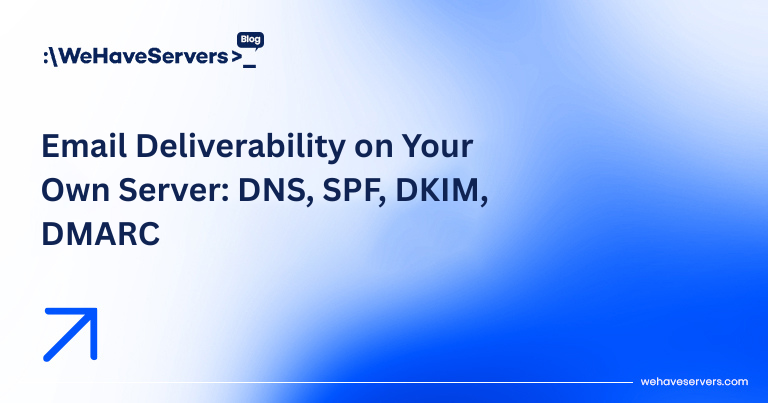
Email Deliverability on Your Own Server: DNS, SPF, DKIM, DMARC
Email Deliverability on Your Own Server: DNS, SPF, DKIM, DMARC
Hosting your own mail server provides control and independence, but it also introduces the hardest challenge: email deliverability. In 2025, major providers like Gmail, Microsoft 365, and Yahoo apply strict anti-spam checks, and without proper configuration your messages may land in spam or be rejected entirely. This guide explains how to configure DNS, SPF, DKIM, and DMARC, along with additional best practices to maximize the chances that your emails reach inboxes.
🔹 Core DNS Records for Email
Email deliverability starts with DNS. Each outgoing mail server must have the correct set of records:
- MX (Mail Exchanger): Defines where mail is received for your domain.
- A/AAAA Records: The IP address of your mail server (IPv4/IPv6).
- PTR (Reverse DNS): Critical for reputation. The IP must resolve back to your mail domain.
- SPF: Declares which servers can send mail for your domain.
- DKIM: Adds cryptographic signatures to prevent tampering.
- DMARC: Provides policy instructions to receiving servers.
🔹 SPF (Sender Policy Framework)
SPF prevents spammers from forging your domain in the MAIL FROM envelope. Configure it with a TXT record:
example.com. IN TXT "v=spf1 ip4:203.0.113.5 include:_spf.google.com -all"ip4:Authorizes your server’s IP.include:Allows trusted external senders (like Google Workspace).-all:Rejects mail from unauthorized sources.
👉 Use -all for strict enforcement; ~all is soft fail, less strict but may pass spoofed messages.
🔹 DKIM (DomainKeys Identified Mail)
DKIM signs each outgoing message with a private key; receiving servers verify it with your public key published in DNS.
default._domainkey.example.com. IN TXT "v=DKIM1; k=rsa; p=MIGfMA0G...AB"- Generate keys with
opendkim-genkeyor Postfix/Exim integration. - Keep private key secure on your mail server.
- Use 2048-bit RSA for strong security.
👉 Gmail, Outlook, and Yahoo reject unsigned bulk mail. DKIM is mandatory for good inbox placement.
🔹 DMARC (Domain-based Message Authentication, Reporting & Conformance)
DMARC ties SPF and DKIM together and defines a policy for failed checks.
_dmarc.example.com. IN TXT "v=DMARC1; p=quarantine; rua=mailto:dmarc-reports@example.com; ruf=mailto:forensic@example.com; adkim=s; aspf=s"p=none: Monitor only.p=quarantine: Place failures in spam.p=reject: Reject failing emails outright.rua/ruf:Addresses for aggregate and forensic reports.
👉 Start with p=none to collect reports, then move to p=quarantine and eventually p=reject for maximum protection.
🔹 Reverse DNS (PTR)
Without PTR, your emails will almost certainly be flagged as spam. Ensure your mail server’s IP resolves to its FQDN:
203.0.113.5 → mail.example.comMost hosting providers allow setting PTR via control panel or support ticket.
🔹 Additional Deliverability Factors
- HELO/EHLO: Configure your mail server hostname to match its rDNS.
- TLS Encryption: Enable STARTTLS with a valid Let’s Encrypt certificate.
- Greylisting: Reduces spam but may delay first delivery. Use carefully.
- Rate Limiting: Avoid sending too many emails per second from a fresh IP. Warm up gradually.
- Blacklists: Check your IP/domain reputation on Spamhaus, Barracuda, etc.
- ARC Headers: Useful when relaying through trusted intermediaries.
🔹 Mail Server Software Options
- Postfix: Most popular on Linux, integrates with Dovecot and OpenDKIM.
- Exim: Default on cPanel environments, flexible configuration.
- Microsoft Exchange: Used on Windows Server environments, enterprise-oriented.
- OpenSMTPD: Lightweight alternative from the OpenBSD project.
🔹 Monitoring Deliverability
- Use tools like MXToolbox to check DNS records.
- Send test messages to Gmail, Outlook, ProtonMail, and Yahoo.
- Check spam scores with
spamassassinor Mail Tester. - Monitor DMARC reports to track failures.
✅ Conclusion
Running your own mail server in 2025 is fully possible but requires precise configuration of DNS records (SPF, DKIM, DMARC), reverse DNS, and TLS. Proper warm-up, monitoring, and reputation management are just as important as technical setup. Once configured correctly, a self-hosted mail server offers complete control over your domain’s communications while ensuring deliverability to major inbox providers.
At WeHaveServers.com, our VPS and dedicated servers include full rDNS support, dual-stack IPv4/IPv6, and DDoS protection, making them ideal for hosting reliable mail infrastructure.
❓ FAQ
Why do my emails land in spam?
Usually missing or misconfigured SPF/DKIM/DMARC, bad rDNS, or poor IP reputation.
How do I get off a blacklist?
Fix issues, request removal from blacklist operators, and avoid spammy sending behavior.
Is DKIM required?
Yes. Major providers like Gmail and Outlook require DKIM-signed messages for inbox placement.
What is IP warm-up?
Gradually increasing the volume of emails sent from a new IP to build reputation with providers.
Can I host email on IPv6 only?
Not reliably. Many providers still require IPv4 connectivity. Use dual-stack IPv4/IPv6.



